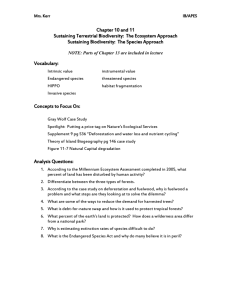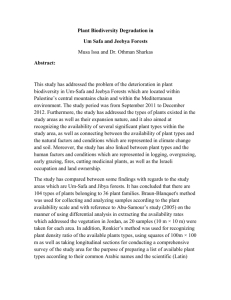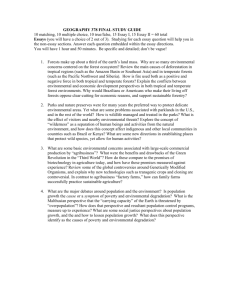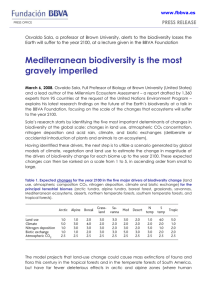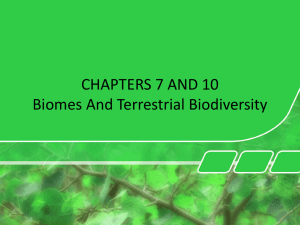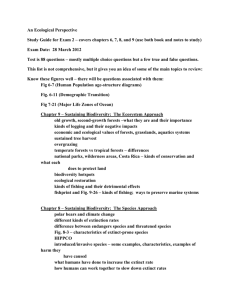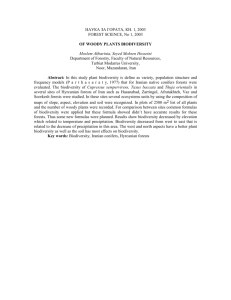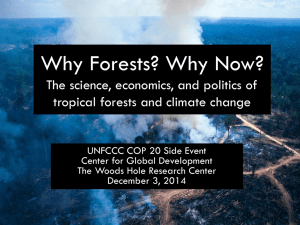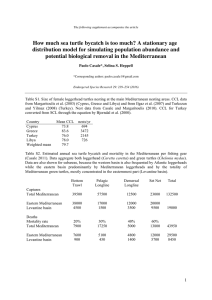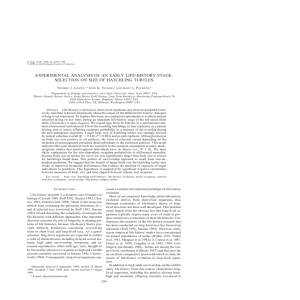The peak of Mt Kilimanjaro as it has not been seen for 11000 years
advertisement
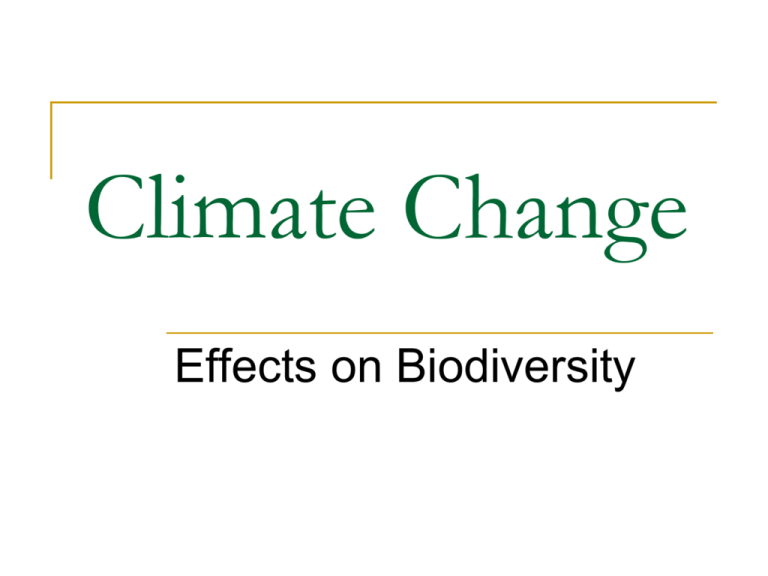
Climate Change Effects on Biodiversity The peak of Mt Kilimanjaro as it has not been seen for 11,000 years 1980 1980 2007 2007 Upsala glacier 1928 2004 Foto: © Greenpeace/De Agostini/Beltra Drivers of loss Latest IPCC report summary (2/07) Ocean absorbing > 80% extra heat, causing water to expand and sea levels to rise. 1961 and 2003 average sea level rose by 1.8mm a year. 1993 and 2003 rose by 3.1mm a year. Arctic temperatures increased x2 the global average rate over the past 100 years, and the ice has shrunk by 2.7% each decade. More intense and longer droughts, particularly in the tropics and sub-tropics North Atlantic there has been an increase in the incidence of typhoons and hurricanes. Biodiversity implications? Die-offs Coral bleaching die-offs of up to 50% in the Indian Ocean Extinctions A species of Golden Toad in Costa Rica Life Cycles Gothic marmots emerge from hibernation about a month earlier than 30 years ago Physiology The average weight of adult female polar bears has decreased by more than 20% over the last 25 years A big “loser”: Coral Reefs Escalating level of carbon dioxide in the atmosphere is making the world's oceans more acidic (not a simple C “sink”) pH of oceans stable 1000 -- 1800, dropped one-tenth of a unit since the Industrial Revolution and likely another 0.3 units by 2100 CO2 forms carbonic acid and lowers ocean pH, making it harder for corals, plankton and marine snails to form their body parts. Big changes in “Phenology” with unknown effects…advance of spring events (bud burst, flowering, breaking hibernation, migrating, breeding) Root TL, Price JT, Hall KR, Schneider SH, Rosenzweig C, Pounds JA. 2003. Fingerprints of global warming on wild animals and plants. NATURE 421 (6918): Alastair Fitter… Poleward range shifts have been documented for individual species, as have expansions of warm-adapted communities, on all continents and in most of the major oceans. Nearly 60% of the 305 species found in North America in winter are on the move, shifting their ranges northward by an average of 35 miles. Range-restricted species, particularly polar and mountaintop species, show more severe range contractions than other groups and have been the first groups in which whole species have gone extinct due to recent climate change Evolutionary responses have been documented (mainly in insects), but there is little evidence that observed genetic shifts are of the type or magnitude to prevent predicted species extinctions. Turtles and global warming Painted Turtles - From Janzen PNAS (1994) Conservation Implications Hatchling loggerhead turtles in Florida from 87 to 99.9 percent females Heavily influenced by beach management a 2 degree C warming of the sand would put temperatures solidly in the female- producing range for the entire population (N. Mrosvovsky and J. Provancha, "Sex ratio of hatchling loggerhead sea turtles: data and estimates from a 5-year study," Canadian Journal of Zoology, v. 70, p. 530 - 538, 1992). Response? Projected temperature changes ~ 2-3 degrees C Slow generation times Remote possibility that turtles can evolve quickly enough to track such environmental change and maintain balanced sex ratios in the wild. The View from New York State… see: http://www.epa.gov/climatechange/index.html By the end of the century, New York summers may feel like those of current-day Illinois Saltmarsh sharp-tailed sparrow, glossy ibis… Moving waters Slower stream velocity, Low depth of flow, High water temperature Higher levels of turbidity All = lower levels of dissolved oxygen Temporary waters Winter Spring Summer Lakes Lake Erie and Lake Ontario Increased evaporation and lower recharge rates Lake Erie levels to decrease by as much as five feet by 2100 Forests Range periphery species Adirondacks are particularly climate-vulnerable “Assisted migration”? Is there a silver lining? …of climate change for biodiversity? Ecosystem resilience: backbone of adaptation Continued supply of ecosystem services depends on capacity of ecosystems to adapt to climate change, e.g.: maintenance of forests in water catchment areas, where landslides are likely to occur after heavy rain, maintenance and restoration of natural wetlands, to store water and regulate water base flows Ecosystem resilience: path to carbon mitigation ; Terrestrial carbon stocks Carbon fluxes in ecosystems Sequester when natural, tC/ha/year Tundra (permafrost) Emit when degraded, tC/ha/year 0 10 0.4-1.5 10-55 6.3 0.5 Temperate peatlands 0 3-5 Temperate grasslands 0.2 0.2 Semi-deserts 0.13 0.13 Boreal forests Temperate mixed forests Steppe -0.0009 In theory PAs is the best solution Why? Because of Carbon permanence Sequestration: capture and storage in: Forests Grasslands Inland waters Marine systems Soil and humus Disaster relief: prevent and retain: Avalanche Hurricane Flooding Tidal surges Drought Protected areas Future resources: from wild species including: Agrobiodiversity Pharmaceuticals Other genetic material Resources: for people: Clean water Fish spawning Wild food Building materials Local medicines Shelter In practice: carbon pools protected and not 85% carbon is outside protected areas Total and stored within the protected areas network (green ) 13.7% of world’s terrestrial area is protected, but contain 15.2% of C stock Work ahead to expand role of PAs Increase coverage, level of protection and management effectiveness, Integrated protected areas in territorial plans – networks, corridors, incl. trans-boundary, Carbon stock management, incl. linkages to carbon markets Ecosystem-based adaptation Outside PA’s: REDD+ Reducing Emissions from Deforestation and Forest Degradation "plus" conservation = the sustainable management of forests and enhancement of forest carbon stocks) Generates funding and political will to protect forests combat climate change improve human well-being in developing nations. REDD+ a suite of policies, institutional reforms and monetary incentives for developing countries to reduce “DD” Governments, industry and local communities Developing countries: Need policies and technical capacity, legal frameworks and financial mechanisms in developing countries Industrialized countries need policy and business leaders involved market-based approaches to create a demand for forest carbon offsets REDD+: A Win-Win for Climate and Biodiversity Rate of extinctions projected to be dramatically reduced By 46-80 percent over a period of five years But only if: Viable investment opportunities exist. Developing and advancing standards that stimulate markets for forest carbon. Private sector investment in REDD+ is catalyzed Energy and the Environment Energy policy is a national priority and is critically important in Central and Western New York. Sound national energy policies will enable America to obtain energy supplies from a wide range of sources in a way that is best for the economy and at the same time addresses homeland and national security considerations while creating incentives for responsible stewardship of the nation’s resources and environment. The solution was not, is not, and never will be “cap and trade” legislation. The passage of a cap and trade bill would mean that the federal government would set a limit on the amount of pollution companies are permitted to emit and require them to obtain allowances or credits for that specific amount. …Cap and trade legislation would place an enormous burden on Central New York families – higher gasoline prices, higher heating costs, higher energy taxes, higher unemployment. Cap and trade, if enacted, would create a new national energy tax, destroy jobs and economic growth, and further damage the economy for decades to come. http://www.buerkleforcongress.com/index.php/issues/ End climate change
